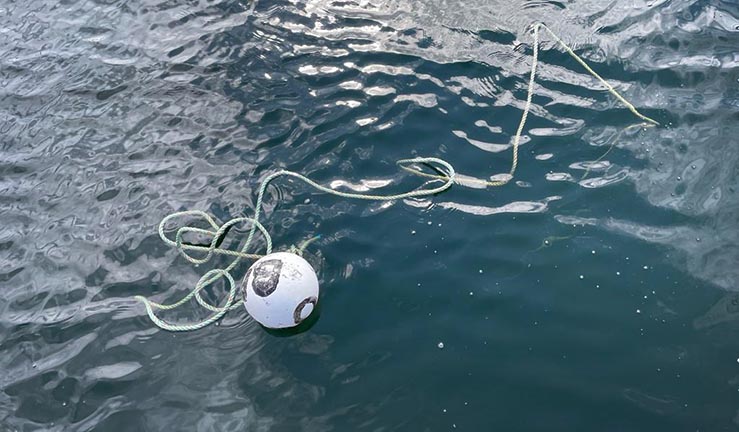Musings on Scottish Cruising

I’ve spent a disproportionate amount of time wondering how to head this article. “End of Season Reflections” didn’t sound right as, although we’re well into autumn, some of us sail right through until others will be launching their boats again some time in 2023. Equally, “Mid-season Thoughts” didn’t seem right either. So, it is what it is, musings rather than more elevated thoughts or reflections. If any of you would like to muse in response, please feel free especially if, as they say elsewhere, you have been affected by any of the issues mentioned in this article.
Unmarked Creels
During the course of our cruising this year, it would be fair to say that as a family we have become partial, almost addicted, to night passages. So far we’ve made three 36 hour passages (more on this below). Along with all the usual things we’ve had to watch out for, such as not falling asleep, not wandering off course, not accidentally running into land or hitting rocks or misinterpreting the lights of the ferry heading towards us at 16kts, getting the prop or keel tangled up in a floating or semi-submerged rope attached to a creel or badly lit fish farm has been the one uppermost in my sub-conscious, so to speak. We are fortunate in Scotland that the Marking of Creels (Scotland) Order 2020 made it mandatory for creels set by registered fishermen to be marked by marker buoys specifically designed for the purpose, and for the boat’s Port Letter and Number to be clearly marked. The impact has been a noticeable improvement since the days when empty plastic milk bottles and other such detritus were cunningly used to disguise the presence of a creel and lure the unsuspecting boater into several hours of hypothermic treading of water by the prop with the bread-knife clenched between chattering teeth, vainly trying to clear the obstruction and avoid the necessity of a Mayday. However, there still remains the danger of unmarked floating or semi-submerged lines from creels or fish-farms, ready to ensnare the unwary.
Although the RYA has a scheme (see link) for reporting floating lines, I’m not sure how widely known it is. It is also difficult to gauge the seriousness of the problem. We have all heard anecdotes of boaters who have become entangled in lines or discarded fishing gear, but I’ve never actually met anyone to whom this has happened. The RNLI doesn’t appear to maintain statistics for the number of boaters they’ve rescued who’ve had their props or keels fouled by floating lines. It would be useful to know the extent to which this is a real issue and how widespread it might be. You could help by making the reporting scheme more widely known and by letting us know if you have had any direct experience of floating lines whether attached to creels, fish-farms or similar. In the meantime as well as changing my shaft anodes I’ll be sharpening my rope-cutter as part of winter maintenance.

Safety on Passage
Back to the night passages. As well as the two overnighters that comprised our 36 hours or so from Clyde Marina to Oban – the daylight hours reserved for passing through the Crinan Canal – we did a couple more on the return leg. Instead of just heading down from Kilmelford Yacht Haven round the Mull of Kintyre and back to Clyde Marina, we decided on some international travel and to make landfall in the Republic of Ireland. Our original intention had been to make for Skerries, some 30 NM north of Dublin but due to the weather we switched to Carlingford Lough. The overnight leg of the passage was down the Irish Sea where we went from almost no wind to a northerly 20 – 25 kts with a following sea under furled genoa, and then back to ghosting along under three sails (we’re a ketch). I should say that my crew were my two sons (both musicians and Day Skippers) and my 14 year old grandson. Many others can better describe the wonderful vibe of night passages. We keep a watch system whereby each adult will have a three hour watch but then stays on for an hour with his relief watch, making four hours in total. This means that no-one is alone at the helm for more than a two-hour stretch, there is a regular supply of tea/coffee/biscuits, and an extra pair of hands to act as deck hand, write up the log and mark our position on the paper chart. My grandson can chose to join a watch or sleep through the night but is not included on the formal watch list.
As Skipper, I am always on call and hover in that strange reverie between sleep and instant action. There is something mystical and elemental about the hushed voices from the cockpit, the glow of the red light above the chart table, the sounds of the kettle boiling, water hurrying by inches from your ear, the rattle of winches and sheets as the watch keepers trim the sails, reef, tack or gybe. I trust the judgement of my crew and know that they would call me if the sea state or weather deteriorated. The wind increased during my watch so by the time I went below, we had a couple of reefs in the main and one in the mizzen. As I lay in my bunk in a semi-doze, I heard them put a further reef in the main, then drop it and the mizzen altogether. The sound of the engine starting (a safety measure), feet on deck above me and the clatter of the sails descending, along with changing angle of the boat in the water were far from alarming as they were all familiar sounds and sensations from daylight activities. For the record I should add that lifejackets are mandatory at all times, even in the marina, and lifelines have to be clipped on whenever we are reefed during the day and at all times at night. The helm is not allowed to go forward from the cockpit when alone on watch but must wait until there is another member of crew awake and clipped on in the cockpit.
Pleasure Craft Report Service
One of the reasons for our international travel was to see how easy or difficult it was to use the new on-line form, introduced on 25 July 2022, to inform the UK Border Force that you are entering or leaving the UK by “pleasure craft” (would all crew agree with that description?). Pithily referred to as the “Pleasure Craft Report Service” (sPCR), it was surprisingly easy and user friendly to complete. Once having created an account (no payment needed), passage plans can be lodged a minimum of 2 hours and a maximum of 24 hours before departure. You can store details of your vessel, including MMSI number, AIS and comms. Equipment carried, as well as names and passport numbers of the usual skipper and crew. If weather conditions dictate changes to your timings or destination or a cancellation of your trip, that is all easy to do whilst on passage, so long as you have phone signal. Although not perfect, it seems more user friendly that the notification system it is replacing.

Disposal of Flares
Employing the old adage, “Plan, Predict, Pre-empt”, part of passage planning involves thinking about what we might do if “things” go wrong. The list of “things” could be endless but can be lumped into various categories such as: MoB/crew incapacitated, mechanical failure, rigging failure, weather related, hitting something. There are, of course, more. Once my mind starts going down that track, one of the factors in the equation is how to attract attention and get help. What if, as happened to a friend of mine, you are 40 miles off-shore (no phone signal), the batteries are flat, the engine won’t start and your genoa has blown out, the wind is increasing and so is the sea state. Hurray for flares. How many of us are carrying around a pack of flares for that” just in case” moment you hope will never arise? Me, for a start. But flares don’t last forever and old ones can be difficult and expensive to dispose of. I’m sure we have all wondered why there aren’t more flare amnesties or why we can’t hand in outdated flares at RNLI or Coastguard stations. In a recent discussion I had with a couple of Coastguards it became clear that there a number of practical and logistical difficulties with such suggestions.
Technically, out of date flares are regarded as ordinance that are potentially dangerous and there are regulations governing their disposal. Not all Coastguard or RNLI stations have the facility for the reception and/or storage of old flares. They need to be stored and transported in "cages" that have a limited capacity by people who are licensed to handle and move them. The RNLI have some 8 stations around the country (Scotland) that can receive them, and they have a contract with a company for their storage, transport and disposal. That is why there is not a general arrangement for people to hand in their out of date flares at any and every RNLI/Coastguard station and the impossibility of organising an amnesty at an event such as a Boat Show.
When I mentioned the cost of disposing of old flares at chandlers and how that led to people hanging on to them, thus adding to the risk of detonation and fire on board, the Coastguards said that the cost of disposing of old flares was minimal compared with the cost of replacing them. The RNLI and Coastguards strongly advocate that boaters equip themselves with AIS transceivers, PLBs and EPIRBs instead of the old traditional flares. As a fall-back, there are also electronic flares now available............ To reinforce the argument, the Coastguards compared the time taken to pinpoint a mariner in distress using a flare, which depends on nearby vessels or someone watching from the coast (if near enough) to see and report the flare - all of which takes time, and the casualty's position may have changed considerably by the time the Coastguards and RNLI have been alerted. Of course, the flare may go unnoticed or unreported. A PLB or EPIRB, once activated, will alert the authorities within seconds to an emergency and the position of the potential casualty. The track of any vessel linked to the PLB or EPIRB can be monitored by AIS.
They argued their case with a degree of passion born, I suspect, of experience.
The Chair and members of the Cruising and General Purpose Committee and Coastwatchers would be interested in others’ observations and experiences over the season to help expand the knowledge base to protect safe, successful and rewarding boating in Scotland.
Please contact ChairCGPC@ryascotland.org.ukfor more information about the Cruising and General Purposes Committee to see how you could help.
